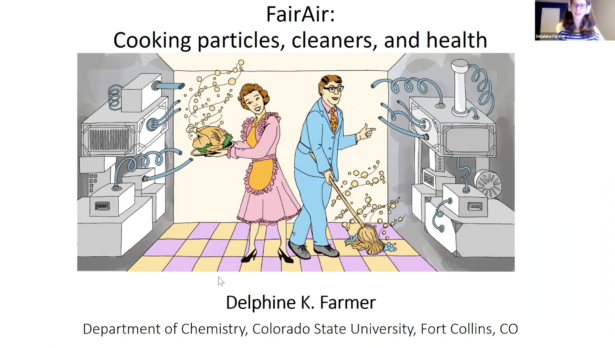“Homes are incredible chemical reactors,” Dr. Farmer states as she introduces the topic of indoor air quality, and the everyday activities we do that introduce gases and particles into our homes. In her presentation Dr. Farmer discusses results from a study that characterized chemical compounds that are released when we cook, clean, and even breath. Dr. Farmer offers a few tips for what we should and shouldn’t to keep our indoor air clean.
Missed the first lecture by Dr. Delphine Farmer, from Colorado State University? You can listen to the recording here. We cataloged questions Dr. Farmer answered below the video along with answers to a few others we didn’t get to.
Questions answered in the video’s discussion:
What about biological pollutants, such as from pets. Are they a major factor in indoor air quality?
How bad is acrolein for you?
If the outdoor air quality is worse then indoor, then cooking outside is not better, correct?
Is it safe to mix 50/50 alcohol and peroxide in a spray bottle to use as an air sanitizer of sorts?
I’m curious about indoor swimming pools, where the air smells strongly of chlorine. Toxic to your health?
What do different cooking surfaces – cast iron, non-stick – do to chemistry?
About how long should you keep your kitchen fan on after cooking dinner?
What about all the cleaners we use in school to sanitize like wipes.
After how many years is it recommended to replace carpet in your house? (carpet holding dust, dirt, etc.)
How well do air purifiers work?
Do air purifiers remove gases from cleaning products?
Interested in latest review of indoor PM2.5 filtration systems for residential use. Individual costs vs. collectively pooling our resources to mitigate the sources.
Questions that we ran out of time on, but are answered here in text
Q: I retrofitted my house with an HRV that runs incoming air through filters. I typically use a MERV 8 prefilter followed by a MERV 11. Is that adequate for indoor air quality?
A: (Bill Simpson) I got a reply from participant Mike Musick, which is “Please check out the Ventilation Solutions website that my son, Richard, has put together to find the details for effectively cleaning up indoor air. The questions of why filter air and how to filter are explained very clearly. In 2004 Fairbanks was surrounded by forest fires. The air was dangerous to breathe. I was the LEED AP on the design and construction of the Cold Climate Housing Research Center. My boss, Jack Hebert, said that he wanted the Research Test Facility to be a refugium during bad outdoor air quality events. On behalf of CCHRC, Bill Reynolds with some assistance from me, bench tested numerous combinations of air filters down stream from an HRV. We came up with a 3 filter system that included a “rock catcher” MERV 8 1”x16”x20” pre-filter, followed by a 2”x16”x20” near HEPA filter that was followed by a 2”x16’x20” activated carbon filter. At Ventilation Solutions Richard has made improvements that you can read about on his website: <www.ventsolutionsfbx.com>. I hope this helps.”
Q: Can we add a list of suggested cleaners? Delphine talked a lot about how bad bleach and other cleaners were but I wasn’t sure what we were supposed to use in their place.
A: (Delphine Farmer) Soap and water is great – but from a what-product-should-I-buy, ‘natural product cleaners’ are great and we find have lower VOC emissions than many others as well; pinesol-type cleaners don’t produce anything toxic either. I generally try to go for the least scented I can find as they release less reactive VOCs
Q: I would be interested in any information related to health risks related to radon in indoor air.
A: The Cooperative extension has information about Radon: http://cespubs.uaf.edu/index.php/download_file/1487/. The State of Alaska also has information: http://dhss.alaska.gov/dph/Epi/eph/Pages/radon.aspx



Thank you for this talk and providing a recording!